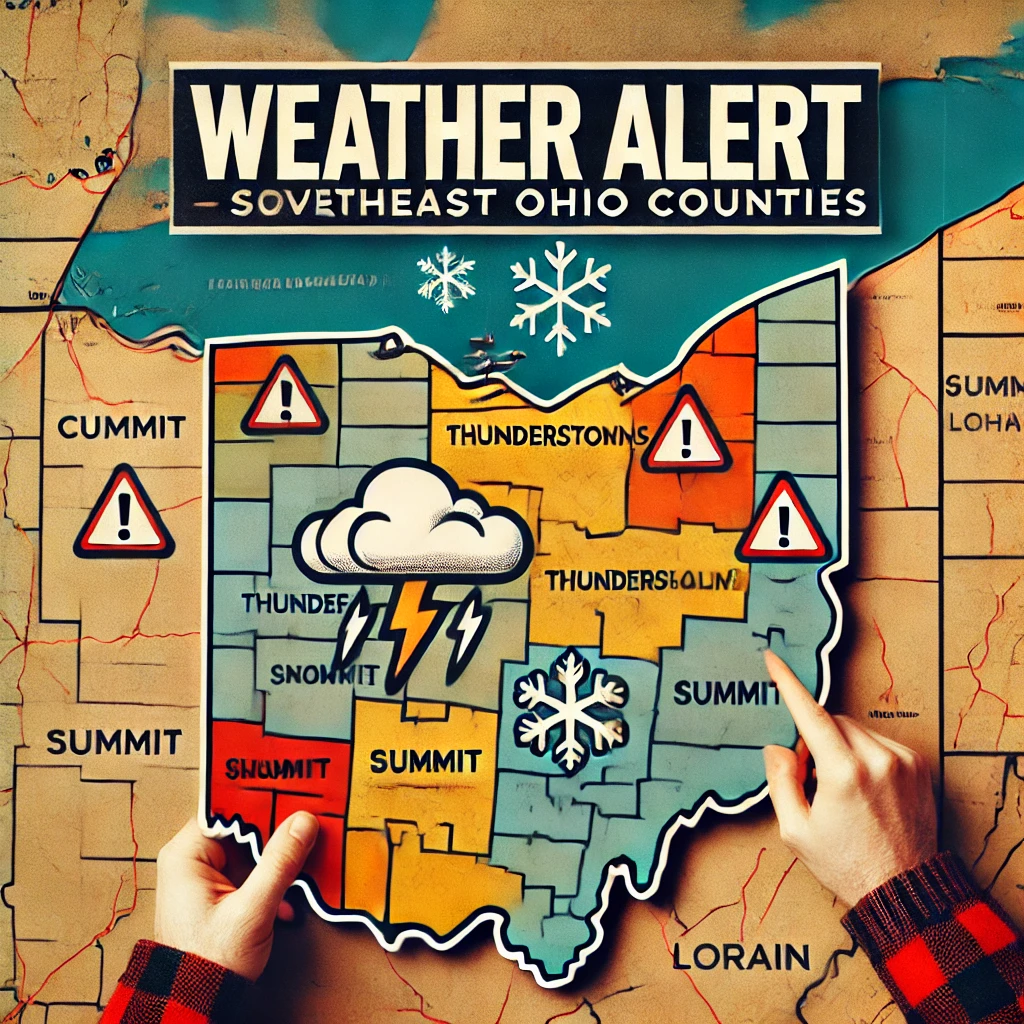When you live in Northeast Ohio, weather patterns can shift rapidly. If you’re a resident of this region, you’ve probably experienced a variety of weather alerts that are issued for several Northeast Ohio counties. From snowstorms to heatwaves, understanding these warnings is crucial for keeping yourself and your loved ones safe. This comprehensive guide will break down the types of alerts commonly issued for Northeast Ohio counties, their importance, and how you can stay informed and prepared.
Why Weather Alerts are Issued for Several Northeast Ohio Counties
Northeast Ohio experiences a wide range of weather conditions due to its proximity to Lake Erie and its varying elevations. Because the region can be affected by lake-effect snow, thunderstorms, tornadoes, and even heatwaves, it’s common for weather alerts to be issued for several Northeast Ohio counties simultaneously.
When a weather alert is issued for multiple counties, it means that the National Weather Service (NWS) has identified a weather event significant enough to impact a larger area. These alerts can vary from watches and warnings to advisories, and understanding the differences between them can help you better navigate the weather risks in Northeast Ohio.
Types of Weather Alerts Issued for Several Northeast Ohio Counties
There are a variety of weather alerts that can be issued for several Northeast Ohio counties. Let’s take a closer look at the most common ones and what each one means for you.
1. Severe Thunderstorm Watches and Warnings
Severe thunderstorms are one of the most common weather phenomena that result in alerts being issued for several Northeast Ohio counties.
– Thunderstorm Watch: This means conditions are favorable for a severe thunderstorm to develop, but one is not currently occurring. Residents should stay alert and monitor weather updates.
– Thunderstorm Warning: A warning means that a thunderstorm is already occurring or imminent. When a thunderstorm warning is issued for several Northeast Ohio counties, it’s a signal to take immediate precautions, such as seeking shelter indoors and staying away from windows.
Severe thunderstorms often bring heavy rain, lightning, strong winds, and even hail, making them dangerous and unpredictable. It’s vital to heed these warnings to avoid accidents or injury.
2. Tornado Watches and Warnings
Tornadoes are rare but not unheard of in Northeast Ohio. When tornado conditions are expected, weather alerts are typically issued for several Northeast Ohio counties to allow residents ample time to prepare.
– Tornado Watch: This means conditions are favorable for tornado development. Residents should be aware of potential dangers and have a safety plan in place.
– Tornado Warning: A tornado warning means a tornado has been sighted or detected by radar, and immediate action is necessary. The NWS may issue warnings for several Northeast Ohio counties simultaneously if the tornado has the potential to impact a large area.
When a tornado warning is issued for several Northeast Ohio counties, seek shelter immediately in a basement or an interior room away from windows. Have an emergency kit ready, and ensure everyone in the household knows the safety procedures.
3. Flood Watches and Warnings
Heavy rains, especially those accompanying thunderstorms or snowmelt, often lead to flood alerts being issued for several Northeast Ohio counties. Flooding is a serious risk, especially in low-lying areas or near rivers and lakes.
– Flood Watch: This means flooding is possible, and residents should be prepared, especially if they live in areas prone to floods.
– Flood Warning: A warning indicates that flooding is already occurring or imminent. Residents in affected counties should seek higher ground immediately and avoid driving through flooded streets.
Flood warnings can cover several Northeast Ohio counties because of the region’s interconnected river systems and drainage areas. It’s essential to monitor these alerts closely, as floodwaters can rise quickly and without warning.
4. Winter Storm and Blizzard Warnings
Winter in Northeast Ohio is notorious for snowstorms and blizzards, making it common for alerts to be issued for several Northeast Ohio counties during the colder months.
– Winter Storm Warning: A winter storm warning is issued when significant snow accumulation, ice, or a combination of both is expected. This alert is often issued for several Northeast Ohio counties because these weather systems can span large areas.
– Blizzard Warning: A blizzard warning indicates strong winds and heavy snowfall that reduce visibility and make travel extremely dangerous. When a blizzard warning is issued, residents should avoid travel and stay indoors until the storm passes.
These winter weather alerts can last for days and severely impact transportation, power lines, and even daily activities. It’s important to be prepared by stocking up on essentials and following the advice of local authorities.
5. Heat Advisories and Excessive Heat Warnings
Though more common in the summer months, heat advisories and excessive heat warnings are also occasionally issued for several Northeast Ohio counties.
– Heat Advisory: This means that temperatures or humidity levels are expected to be dangerously high, posing a risk to vulnerable populations such as children, the elderly, and those with health conditions.
– Excessive Heat Warning: An excessive heat warning is issued when conditions are extreme and prolonged, with the potential to cause heat-related illnesses. It’s important to stay hydrated, avoid strenuous activities, and remain in air-conditioned spaces during such warnings.
How Weather Alerts Are Communicated in Northeast Ohio
Staying informed about weather alerts is crucial for your safety, and there are several ways you can stay updated when alerts are issued for several Northeast Ohio counties.
1. NOAA Weather Radio: This is one of the most reliable ways to receive weather alerts, even when power or internet services are disrupted. NOAA radios provide real-time updates on watches, warnings, and other weather information.
2. Local News and Weather Stations: Many residents rely on local TV stations to receive up-to-the-minute weather alerts and forecasts. When alerts are issued for several Northeast Ohio counties, they are often broadcast live, with detailed instructions on how to stay safe.
3. Weather Apps and Alerts: Most smartphones come equipped with weather apps that can send notifications when a severe weather alert is issued for your area. You can also subscribe to services such as the NWS’s Wireless Emergency Alerts (WEA), which sends out push notifications in the event of severe weather.
4. Social Media and Websites: Many local governments, weather services, and news outlets use social media to communicate weather alerts. Following these accounts can help you stay informed about alerts issued for several Northeast Ohio counties.
The Impact of Weather Alerts on Northeast Ohio Communities
When weather alerts are issued for several Northeast Ohio counties, the potential impacts can be far-reaching. From disrupted transportation to school closures and power outages, these alerts often serve as a reminder to prepare for the worst.
1. School and Business Closures
Severe weather alerts such as winter storm warnings or tornado warnings can lead to school closures and delayed openings for businesses. It’s important to check with local schools and employers to stay updated on any closures or changes in schedules. These decisions are often based on alerts issued for several Northeast Ohio counties to ensure the safety of students and employees.
2. Disrupted Transportation
Whether it’s due to flooded roads or snow-covered highways, transportation can be significantly affected when a weather alert is issued. Mass transit systems, such as buses or trains, may reduce service or suspend operations entirely during extreme weather conditions.
If you rely on public transportation or need to travel, check road conditions and transit alerts before heading out. When a weather warning is issued for several Northeast Ohio counties, it’s best to avoid unnecessary travel and stay off the roads until conditions improve.
3. Power Outages
Strong winds, ice storms, and heavy snowfall can lead to power outages in Northeast Ohio. When severe weather alerts are issued, it’s a good idea to prepare for potential power loss by having backup batteries, candles, and other emergency supplies ready. Power companies may also send out alerts and updates on restoration efforts during an outage.
Preparing for Weather Alerts in Northeast Ohio Counties
Knowing how to prepare for weather alerts is just as important as understanding the alerts themselves. When a weather alert is issued for several Northeast Ohio counties, follow these steps to ensure you and your family are prepared:
1. Create an Emergency Plan: Make sure everyone in your household knows what to do during a weather emergency. Identify safe places in your home for tornadoes, have evacuation routes for floods, and ensure you have emergency contacts on hand.
2. Stock Up on Essentials: Severe weather can disrupt access to groceries, medicine, and other necessities. Make sure you have enough food, water, medications, and other supplies to last for at least three days.
3. Prepare Your Home: Whether it’s securing outdoor furniture before a storm or insulating pipes to prevent freezing during winter, preparing your home for severe weather can help prevent damage and ensure your safety.
4. Stay Informed: As mentioned earlier, staying updated through NOAA radios, apps, and local news is critical. When alerts are issued for several Northeast Ohio counties, weather conditions can change rapidly, so it’s essential to remain vigilant.
Conclusion
Weather alerts issued for several Northeast Ohio counties serve as an essential warning system to keep residents safe and informed about impending dangers. Whether it’s a thunderstorm, flood, or blizzard warning, understanding the types of alerts and how to respond can make all the difference. The unpredictable nature of Northeast Ohio’s weather makes it important for everyone to stay prepared, remain informed, and take proactive measures when necessary.
When alerts are issued for several Northeast Ohio counties, it’s not just about knowing what’s coming—it’s about acting on that information to protect yourself, your family, and your community. By staying vigilant, using reliable sources for updates, and following emergency procedures, you can weather the storm—literally and figuratively.
Make sure to bookmark your local weather stations, sign up for alerts, and always be prepared for whatever Mother Nature throws your way!











